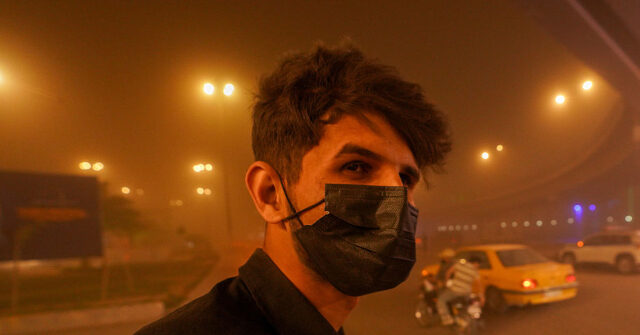A massive dust storm or “haboob” swept across central and southern Iraq on Tuesday, hospitalizing 3,747 people with breathing difficulties according to Iraqi health officials.
Iraqi Health Ministry spokesman Said al-Badr said there were no reported deaths and “no cases admitted to intensive care or elsewhere.” He credited abundant equipment and good training for treating dust inhalation in Iraqi hospitals with avoiding fatalities.
Badr said most of those who reported to hospitals with breathing difficulties have “fully recovered and left after receiving the necessary treatment.”
Hospitals in rural Iraq nevertheless reported being overwhelmed by patients. Regional governors declared states of emergency and ordered extra supplies of oxygen delivered to health clinics.
The dust storm also caused power failures and shut down airports in the provinces of Najaf and Basra, reducing visibility to about half a mile with a heavy orange haze.
Kurdish news service Rudaw noted that dust storms are “common in Iraq,” and have “become more frequent and intense due to prolonged drought, desertification, and rising temperatures.”
“According to Iraq’s environment ministry, the country has been experiencing 272 dust days per year over the past two decades. That number is projected to reach 300 by 2050,” the report said.
Although every media report dutifully mentioned “climate change” as a factor in Iraq’s problem with persistent dust storms, poor water management and extended droughts are a more proximate cause. The Tigris and Euphrates rivers are particularly vulnerable to regional “water politics,” as Turkey, Syria, and Iraq haphazardly construct dams and irrigation systems, depleting the water levels of the great rivers.
Iraq and Syria were angered when Turkey reduced the water flow of the Tigris and Euphrates by building dozens of massive dams and hydroelectric plants. According to some estimates, Turkish dams have reduced Iraq’s water supply from the Tigris and Euphrates by up to 80 percent over the past 50 years.
One new dam project in Turkey, the Ilisu Dam, is forecast to reduce the flow of the Tigris into Iraq by 56 percent. Ever since the dam was completed in 2020, Iraqi officials have been pleading with dam administrators to release more water. Meanwhile, Kurds living upstream of Ilisu watched in dismay as one of their ancient cities disappeared beneath the rising waters of the dam’s reservoir.
Iraq has also suffered massive deforestation over the past decade, causing more of its land to become desert, and irrigation methods in rural Iraq are notoriously wasteful. Small efforts have been made recently to begin implementing more advanced and water-efficient irrigation technology.
Read the full article here



